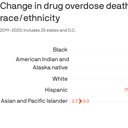Overdose deaths surged in 2020, disproportionately impacting Black and Native American people

Drug overdose deaths surged by 30% during the first year of the pandemic, with Black and Native American communities bearing a disproportionately higher burden, the CDC reported on Tuesday.
Why it matters: The pandemic highlighted long-overlooked disparities in health care and how social determinants like poverty, housing and transportation can hinder access to care, including substance use treatment.
- Fentanyl has accelerated the opioid crisis and is often being laced into other drugs, sometimes unbeknownst to the user.
Takeaways: Overdose rates were highest in areas with the most treatment options available, in 25 states and the District of Columbia, where data was available, the report found.
- "Just because there's availability of services doesn't meant they're necessarily accessible," Mbabazi Kariisa, a CDC health scientist, told reporters.
- Systemic racism, income inequality, and lack of reliable housing, transportation and health insurance all play a role in why drug overdoses are disproportionately affecting Black and Native American people, CDC officials said.
By the numbers: In 2020, there were 91,799 Americans who died of a drug overdose, according to HHS, and from 2019 to 2020 overdose rates increased the most among teens and young adults.
- Black youths and young adults ages 15 to 24 years old experienced the largest overdose death rate increase at 86%.
- Native American people ages 25 to 44 years old saw an increase of 49% in the rate of overdose deaths.
- White people ages 15 to 24 years old had a 34% increase in overdose death rate.
The bottom line: The landscape is evolving, CDC officials said, and illicit drug use as well as poly-substance use is a major cause for concern in communities, especially when fentanyl can kill a person who uses it once.